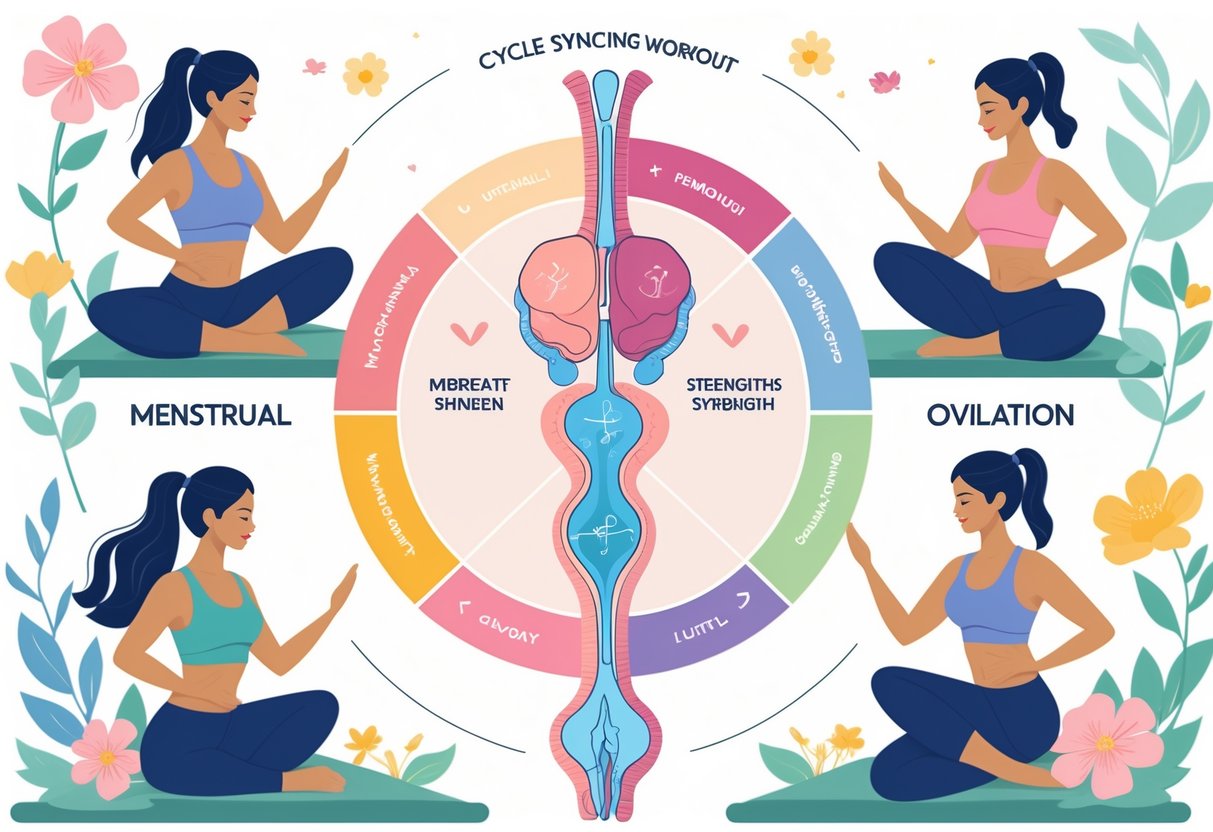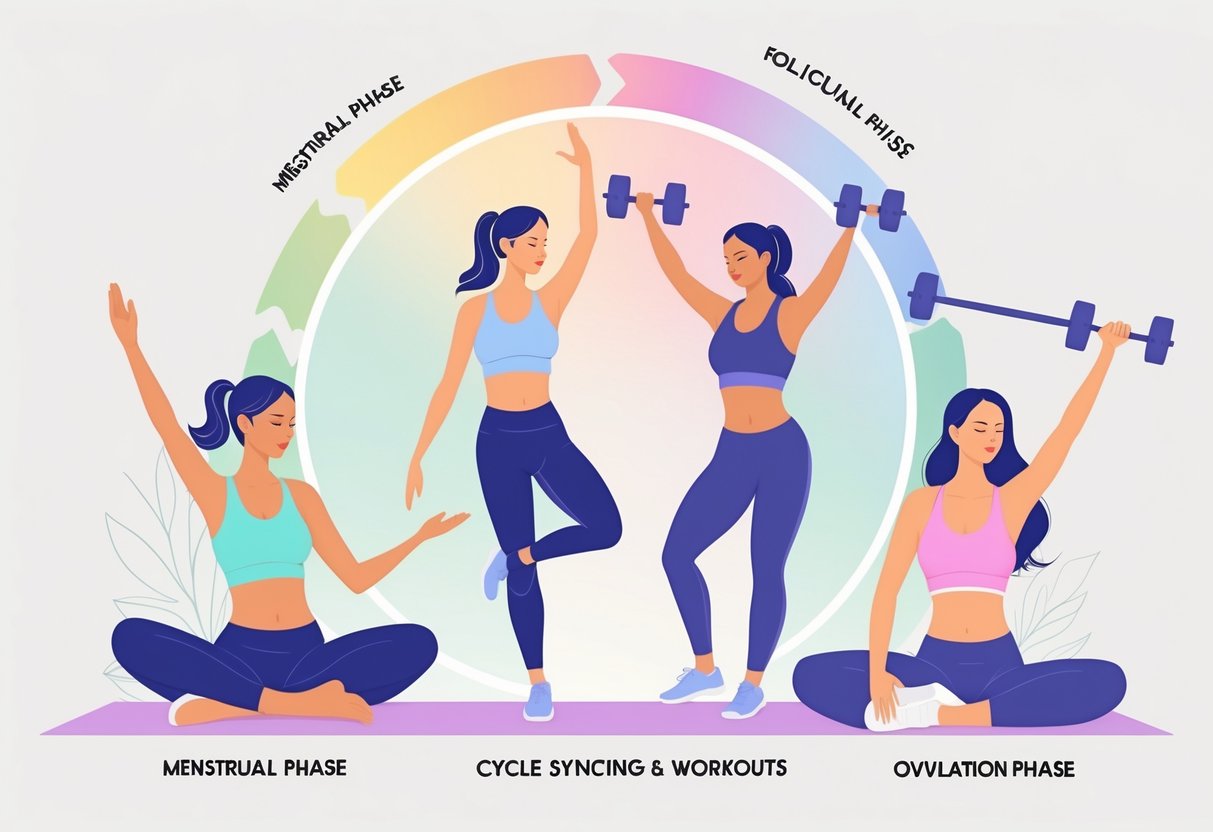Cycle Syncing Workouts Optimizing Fitness Through Your Menstrual Cycle
Ever wish your workouts could actually work with your body, not against it? That’s what cycle syncing is all about.
By matching our exercise routines with the natural phases of our menstrual cycle, we can boost energy, manage symptoms, and even see better results from our efforts. No more pushing through days when we’re just not feeling it; instead, we get to work smarter, not harder.
If you’ve ever wondered why some weeks the gym feels great and others it’s just… a struggle, you’re not alone. Our hormones have a big say in how we feel and perform throughout the month.
Cycle syncing is an easy way to listen to our bodies and make those ups and downs actually work for us.
Key Takeaways
- Syncing workouts with our cycle can help us feel and perform better.
- Small changes in exercise and nutrition can fit each phase of our cycle.
- Understanding our bodies helps us manage symptoms and make fitness more enjoyable.
Understanding the Menstrual Cycle and Its Phases

Hormones run the show when it comes to our monthly cycles. They’re busy shifting our bodies through four unique phases, and each one can impact our energy, mood, and even the way we work out.
Let’s break it all down—no science degree needed.
The Menstrual Phase
This is day one, the very start of things. Technically, our cycles begin when our periods start.
During the menstrual phase, the uterine lining sheds, and we get our period, usually lasting about 3 to 7 days. Energy often dips as hormone levels, like estrogen and progesterone, are at their lowest.
Headaches, cramps, and fatigue? Yep, that’s pretty normal.
We’re not superheroes during this week, so it’s a good time to take it easy if we need to. Our bodies might crave rest or lighter exercise like walking or stretching.
Some of us find that moving a bit actually helps the aches, while others prefer a few rest days. Both approaches are totally valid, so we shouldn’t feel guilty about slowing down.
Follicular Phase Overview
Once our periods wrap up, we step into the follicular phase. This phase usually covers days 1 to 14 but overlaps a bit with menstruation at the start.
Here, the hormone estrogen gradually rises, preparing a new egg in the ovary. Think of this as a kind of “spring” for our bodies—fresh energy, clearer minds, and better moods are pretty common.
That rising estrogen isn’t just for show. It boosts feelings of motivation, making us more likely to want to try a new sport or push ourselves a bit harder during workouts.
HIIT classes, runs, and strength training often feel easier now. If we’ve got goals, this is the window to go for them.
Ovulation Phase Explained
Ready for a spotlight moment? The ovulation phase is a short but important one.
It’s when an egg gets released from the ovary, usually around the middle of our cycle, like day 14. Estrogen peaks now, and so does luteinizing hormone (LH)—the one that triggers ovulation.
Some of us might notice we feel at our very best. Our energy, confidence, and drive can soar.
It’s not unusual to feel a bit warmer or even more social. Workouts may feel powerful and satisfying.
But some people get mild cramps or feel a little off, too. Every body is different!
Keeping hydrated helps, and being mindful of form in high-impact workouts is a good idea because joints can get slightly looser during ovulation. We can use this short burst of high energy for more intense or group-based workouts if that feels right.
Luteal Phase Breakdown
Right after ovulation, the luteal phase steps in for the final act. Lasting about two weeks, it’s when progesterone rises and the body gears up for a possible pregnancy.
We might feel warm and sleepy, and some get cravings or mood swings—this is when PMS can show up. Workouts sometimes feel tougher, and it’s normal for motivation to dip a little.
It’s smart to listen to our bodies here. Low-impact exercises, like swimming or yoga, usually feel better than intense routines.
Still, if we feel good, we can absolutely keep up with our regular workouts—just tweak things if we notice big changes in our energy. Taking extra care with sleep and stress also goes a long way during this phase.
What Is Cycle Syncing and How Does It Work?

Cycle syncing is all about matching our workouts and daily habits with the natural phases of our menstrual cycles. By noticing how our bodies change during each stage, we can get more out of exercise and even feel better in our everyday lives.
Principles of Cycle Syncing
Cycle syncing uses the four main phases of the menstrual cycle: menstrual, follicular, ovulatory, and luteal. Each phase comes with its own mix of hormones.
For example, during the menstrual phase, many of us feel tired, so gentle exercises like yoga or walking might feel just right. When we move into the follicular phase, energy often rises, making it a smart time to try new workouts or increase intensity.
As we reach the ovulatory phase, estrogen peaks. Our bodies often feel strong and motivated, so we might want to schedule our toughest workouts here.
Finally, in the luteal phase, hormones start to dip again, and high-intensity routines can feel exhausting, so slower paced or restorative workouts are usually best. In a way, it’s like working with our physiology, not against it.
